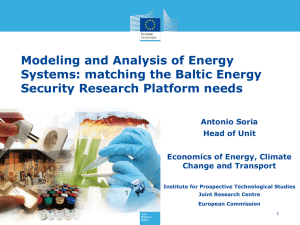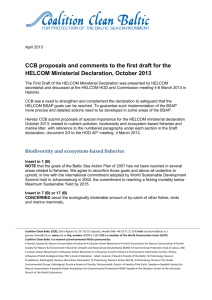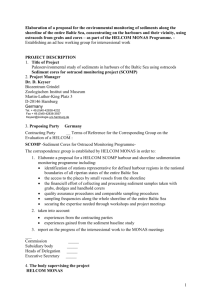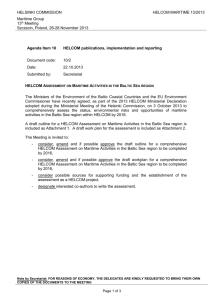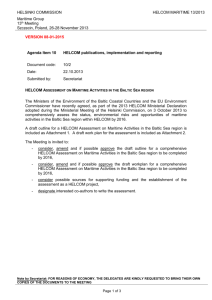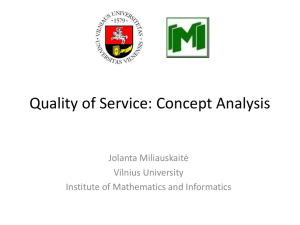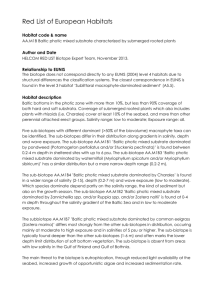environmental challanges of the baltic sea and international
advertisement
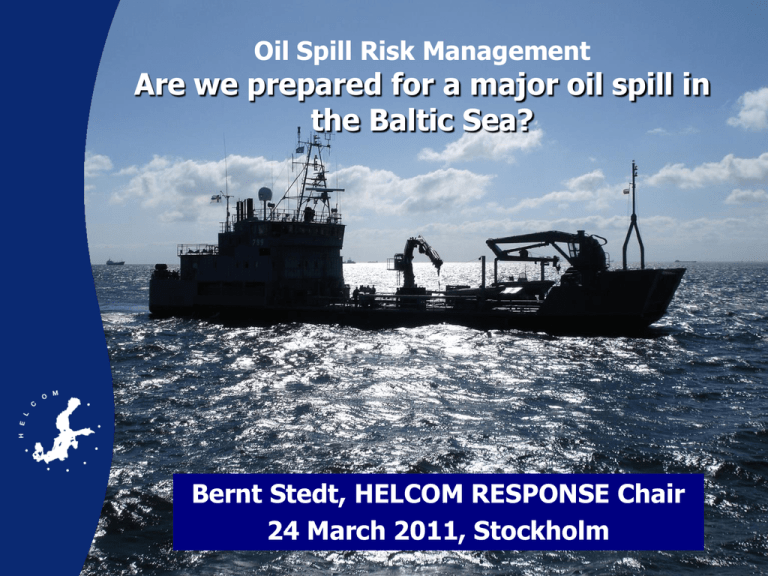
Oil Spill Risk Management Are we prepared for a major oil spill in the Baltic Sea? Bernt Stedt, HELCOM RESPONSE Chair 24 March 2011, Stockholm - Contents: The Baltic Sea Regional cooperation through HELCOM Proven preparedness in the Baltic BRISK/BRISK-RU risk assessment Main concerns for the Baltic Sea • Eutrophication • Pollution by hazardous substances • Maritime activities • Loss of biological diversity Maritime traffic Amount of oil turnover in the largest Baltic oil terminals 300.0 Million tonnes • 2000 ships at any given moment • In 2009, vessels entered or left the Baltic Sea via Skaw 62,743 times increase by 20% since 2006 • 21% of those ships were tankers • Also heavy ship traffic through a Kiel Canal – 30,314 ships • The strongest growth in shipment of oil - from the Gulf of Finland 250.0 200.0 150.0 203.5 137.7 108.1 122.8 245.3 251.4 221.2 233.7 162.4 170.3 100.0 50.0 0.0 1997 2000 2001 2002 2003 2004 2005 2006 2007 2008 Shipping accidents In 2009: • 105 shipping accidents • Groundings (36%) and collissions (32%) are the most common • Human factor is the main cause of accidents • 5 accidents resulted in oil spills HELCOM • Helsinki Commission (HELCOM) International cooperation since 1974 (new Convention signed in 1992) • Main task: to protect the marine environment of the Baltic Sea from all sources of pollution • 10 Contracting Parties (9 Baltic Sea Coastal States and the EU) • Secretariat located in Helsinki, Finland Proven preparedness to respond to pollution incidents in the Baltic • HELCOM Response Group co-ordinates the work • A number of HELCOM Recommendations covering: − response to spills of oil or hazardous substances at sea, from offshore units and oil terminals − requirements on emergency and response capacity − airborne surveillance − restricted use of dispersants − development and use of drift forecasting systems • HELCOM Response Manual (Vol. I Oil + Vol. II Hazardous Substances) − Reporting procedures − Requesting and providing assistance − Command structure and communication during operation − Oil sampling − Co-operation on aerial surveillance Existing emergency and response capacity • A high number of emergency and sea-going response vessels, including 3 chartered by European Maritime Safety Agency • New vessels to be built in coming years • Satellite and aerial surveillance • Oil drft forecasting tools (HELCOM Seatrack Web) Aerial surveillance in the Baltic • Co-ordinated regular surveillance activties in the whole Baltic • Efficiency - development and improvement of the existing remote sensing systems • Satellite surveillance in co-operation with EMSA • CEPCO and Super CEPCO Flights • Annual reports to HELCOM for evaluation Regular exercises • National and bilateral operational exercises involving response units • International operational exercises with participation of all Baltic Sea States (BALEX DELTA) – – – – – – – – – – 2001 2002 2003 2004 2005 2006 2007 2008 2009 2010 Denmark: 7 countries, 11 ships, 2 aircraft Latvia: 6 countries, 18 ships, 2 aircraft Finland: 5 countries, 16 ships Germany: 6 countries, 11 ships, 1 aircraft Sweden: 7 countries, 19 ships, 2 aircraft Poland: 7 countries + EMSA, 23 ships, 3 aircraft Estonia: 6 countries + EMSA, 17 ships, 1 helicopter Russia: 6 countries, EMSA, 17 ships, 2 helicopters Latvia: 5 countries + EMSA, 9 ships Klaipeda: 7 countries + EMSA, 8 vessels • Main objective - every Contracting Party should be able to command a major response operation Major accidental oil pollution • 1990 ”Volgoneft” 700-800 t. of waste oil – 5 countries; more than 20 ships – nearly all oil recovered at sea • 2001 “Baltic Carrier” 2700 t. of oil – 3 countries – around 50% of oil recovered from the water • 2003 “Fu Shan Hai” 1200 t. of fuel oil – 3 countries – around 1100 tonnes of oil recovered at sea HELCOM Baltic Sea Action Plan • Adopted on 15 November 2007 in Krakow, Poland • Regional programme of measures aimed at obtaining a healthy Baltic Sea, including in the response field e.g.: - 2010 Mutual Plan for Places of Refuge – approach beyond national borders - Strengthened regional cooperation on shoreline and oiled wildlife response BSAP - Strenthening of sub-regional co-operation in response field • • Contracting Parties agreed are to: 1. assess the risk of oil and chemical pollution and 2. review emergency and response resources on sub-regional basis in order to ensure sufficient resources to effectively respond to ”medium size” pollution or to control a large scale pollution of the sea Launch of the BRISK and BRISK–RU projects - BRISK under the EU’s Baltic Sea Region Programme 2007-2013 (EUR 2.5 mil. allocated from the European Regional Development Fund) - BRISK-RU financed by the Nordic Council of Ministers - Implementation under umbrella of HELCOM Response Group Part-financed by EU (European Regional Development Fund) BRISK/BRISK-RU activities 2009-2012 • First overall risk assessment of pollution caused by shipping accidents covering the whole Baltic Sea area based on a common methodology – Recognizes the areas with highest risk for oil spills and environmental damage • Identification of missing response resources needed to effectively tackle major spills of oil and hazardous substances • Preparation of pre-investment plans on how the countries can jointly improve preparedness – A joint pool of vessels and equipment for each sub-region – Countries can share the investment burden in a costeffective way • Development of agreements between neighboring countries for joint response operations Conclusions • Cooperation on response to pollution from ships in the Baltic Sea well established • Past shipping accidents in the Baltic Sea proved that the regional procedures in place are functioning • The BRISK/BRISK-RU risk assessment will provide the basis for the decision on the needed investments in response resources • The final results of the risk assessment will be presented on 18/20 May in Gdansk, Poland (European Maritime Day) Thank you! For more information please contact: Helsinki Commission (HELCOM) Katajanokanlaituri 6 B FI-00160 Helsinki Finland www.helcom.fi

